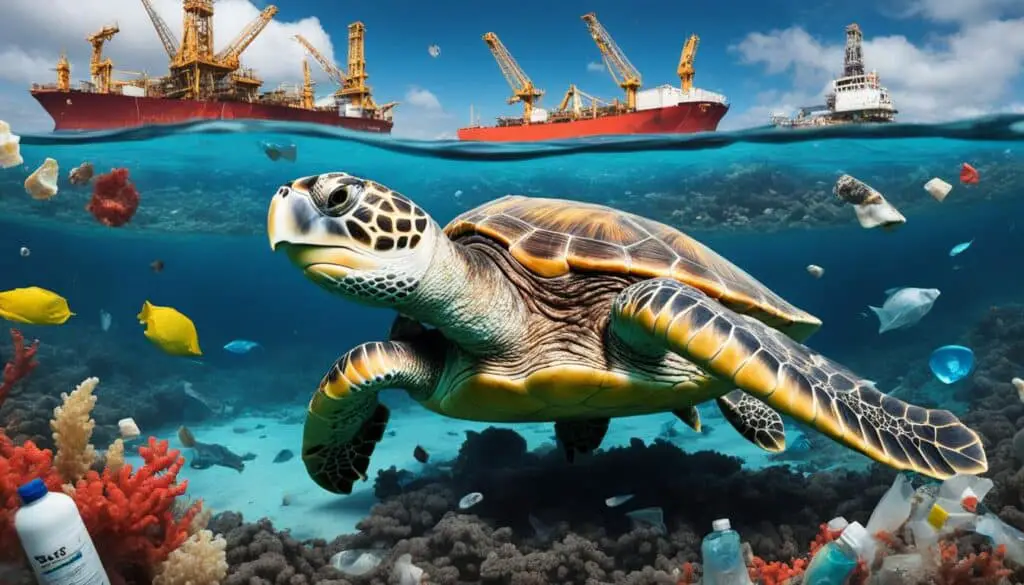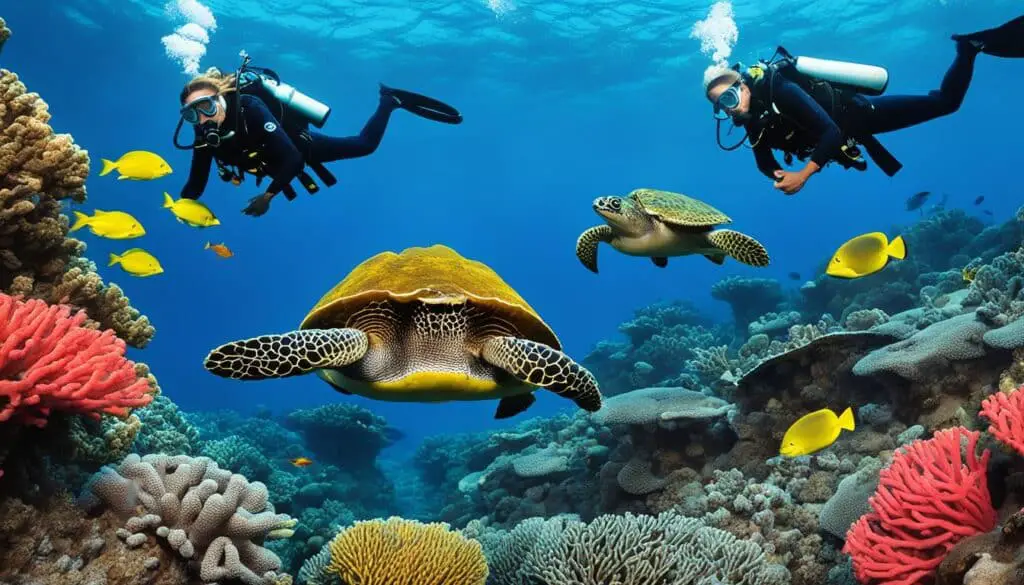I am excited to dive into the fascinating world of the Galapagos Islands. Nestled in the Pacific Ocean, this archipelago is renowned for its breathtaking underwater ecosystems. These diverse habitats teem with endemic marine life found nowhere else on Earth. Join me as we explore the hidden wonders beneath the waves of the Galapagos.
Key Takeaways:
- The Galapagos Islands boast unique and diverse underwater ecosystems.
- Endemic marine species thrive in the isolated habitats of the Galapagos.
- The underwater world of the Galapagos is a paradise for divers and nature enthusiasts.
- Conservation efforts are crucial to preserve the delicate balance of these ecosystems.
- Visitors can support sustainable tourism practices and contribute to the long-term protection of the Galapagos.
Exploring the Galapagos Marine Reserve
The Galapagos Marine Reserve is a vast protected area surrounding the Galapagos Islands. It was established to preserve the unique marine biodiversity of the region and ensure the long-term sustainability of the underwater ecosystems. The reserve covers approximately 133,000 square kilometers and is one of the largest marine protected areas in the world.
Located in the eastern Pacific Ocean, the Galapagos Marine Reserve is a haven for marine life. Its diverse habitats, ranging from coral reefs to open ocean waters, support a wide array of species. From colorful fish to majestic sea turtles, the reserve is teeming with marine biodiversity.
Endemic Marine Species of the Galapagos
The Galapagos Islands are home to a remarkable array of marine life that is found nowhere else in the world. These endemic species have adapted to the unique conditions of the islands’ underwater ecosystems, making them a vital part of the Galapagos wildlife. Studying and protecting these species is crucial for marine conservation efforts in the region.
- Galapagos Sea Lion: The Galapagos sea lion (Zalophus wollebaeki) is a charismatic marine mammal that is highly adapted to its island habitat. With a population estimated at around 50,000, these playful creatures are a common sight in the waters surrounding the Galapagos Islands.
- Galapagos Shark: The Galapagos shark (Carcharhinus galapagensis) is a species of requiem shark found exclusively in the Galapagos Islands. These sharks are known for their distinctive markings and can grow up to 11 feet in length. Despite their intimidating appearance, they are not considered a threat to humans.
- Galapagos Green Turtle: The Galapagos green turtle (Chelonia mydas agassizii) is the only species of marine turtle that nests in the Galapagos Islands. These herbivorous turtles play a vital role in maintaining the health of seagrass beds and coral reefs.
- Galapagos Fur Seal: The Galapagos fur seal (Arctocephalus galapagoensis) is the smallest and rarest of all fur seal species. With a population estimated at approximately 15,000, these marine mammals are endemic to the Galapagos Islands. They can be found basking on rocky shores or swimming in the surrounding waters.
These are just a few examples of the endemic marine species that call the Galapagos Islands home. The diversity and uniqueness of these species highlight the importance of marine conservation efforts in the region. By protecting these fragile ecosystems and the wildlife they support, we can ensure the long-term survival of these incredible species.
| Species | Population | Conservation Status |
|---|---|---|
| Galapagos Sea Lion | Approximately 50,000 | Least Concern |
| Galapagos Shark | Unknown | Near Threatened |
| Galapagos Green Turtle | Approximately 3,000 nesting females | Endangered |
| Galapagos Fur Seal | Approximately 15,000 | Endangered |
Threats to Galapagos Underwater Ecosystems
Despite their remote location, the underwater ecosystems of the Galapagos are facing various threats. Human activities such as overfishing, pollution, and habitat destruction can have a detrimental impact on the delicate balance of these ecosystems. Climate change is also a significant concern, as rising sea temperatures and ocean acidification can disrupt the intricate relationships between species. Efforts are being made to address these conservation challenges and protect the unique marine life of the Galapagos.

| Conservation Challenges | Impact |
|---|---|
| Overfishing | Depletes fish populations, disrupts food chains |
| Pollution | Contaminates water, harms marine organisms |
| Habitat Destruction | Loss of essential habitats for marine species |
| Climate Change | Rising sea temperatures and ocean acidification |
Impact of Human Activities
The Galapagos Islands are not immune to the human impact on the environment. Overfishing threatens the delicate balance of marine ecosystems, depleting fish populations and disrupting the natural food chains. Pollution from sources such as plastic waste and oil spills can contaminate the water and harm marine organisms. Habitat destruction, including coral reef destruction and mangrove deforestation, results in the loss of essential habitats for marine species.
Conservation challenges such as overfishing, pollution, and habitat destruction pose a risk to the Galapagos’ unique underwater ecosystems. Efforts must be made to preserve the delicate balance of these environments and protect the rich biodiversity they harbor.
Climate Change and its Consequences
One of the most significant threats to the Galapagos underwater ecosystems is climate change. Rising sea temperatures and ocean acidification can have severe consequences for marine life. These changes can disrupt the intricate relationships between species, impacting their reproduction, migration patterns, and food sources. Endangered species, such as the Galapagos penguin and marine iguana, are particularly vulnerable to these changes.
Addressing the impacts of climate change is crucial for the long-term survival of the Galapagos’ unique marine life. Collaborative efforts and sustainable practices are essential in mitigating these threats and preserving the biodiversity of this extraordinary ecosystem.
Conservation Initiatives and Sustainable Tourism
Conservation efforts play a vital role in preserving the delicate underwater ecosystems of the Galapagos Islands. Through collaborative endeavors between conservation organizations and local authorities, initiatives are being implemented to protect the marine biodiversity of this unique region.
The Establishment of Marine Protected Areas
One pivotal conservation measure taken in the Galapagos is the establishment of marine protected areas. These designated zones aim to safeguard vulnerable habitats and endemic species by regulating human activities and minimizing their impacts. By creating these protected areas, authorities can ensure the long-term sustainability of the underwater ecosystems.
Enforcement of Fishing Regulations
To prevent overfishing and preserve the delicate balance of marine life, fishing regulations are strictly enforced in the Galapagos. These regulations limit the catch size, fishing methods, and fishing seasons to prevent the depletion of fish stocks and protect the food chain that supports the unique marine ecosystems.
Implementing Sustainable Tourism Practices
Sustainable tourism practices are vital for minimizing the ecological footprint of visitors to the Galapagos. Responsible tour operators and travelers adhere to guidelines that prioritize the conservation of marine life and habitats. By following sustainable practices such as responsible diving and snorkeling, visitors can enjoy the stunning underwater world while minimizing disturbances to the marine ecosystems.
Responsible diving practices include maintaining a safe distance from marine life, avoiding contact with coral reefs or fragile habitats, and not removing any marine organisms or artifacts. By respecting these guidelines, divers can contribute to the preservation of these unique ecosystems for future generations.
Supporting Conservation Efforts
Visitors to the Galapagos are encouraged to actively support conservation efforts through various means. This can include volunteering with local organizations, participating in educational programs, or making donations to support ongoing conservation initiatives. By contributing to these efforts, individuals can directly contribute to the long-term protection of the Galapagos’ extraordinary underwater world.

| Conservation Initiatives | Benefits |
|---|---|
| Establishment of marine protected areas | Preserves vulnerable habitats and endemic species |
| Enforcement of fishing regulations | Prevents overfishing and maintains the balance of marine life |
| Implementation of sustainable tourism practices | Minimizes disturbances to marine ecosystems while supporting local communities |
| Supporting conservation efforts | Directly contributes to the long-term protection of the Galapagos’ underwater world |
Conclusion
The Galapagos Islands are a unique and precious treasure, home to breathtaking underwater ecosystems and a rich variety of endemic marine species. However, these fragile ecosystems face numerous challenges, making conservation efforts and sustainable travel practices essential for their long-term preservation.
By recognizing the importance of Galapagos conservation, we can take steps to protect its unique marine biodiversity. Supporting local conservation initiatives and following sustainable travel practices are crucial in minimizing our impact on the delicate balance of these underwater habitats.
Responsible tourism, such as practicing responsible diving and snorkeling, not only ensures the protection of the underwater world but also allows future generations to continue exploring and appreciating the wonders of the Galapagos. Together, we can make a difference for the Galapagos Islands, contributing to their conservation and safeguarding their remarkable wildlife for years to come.
FAQ
What makes the underwater ecosystems in the Galapagos unique?
The Galapagos Islands are home to unique and diverse underwater ecosystems, which harbor a rich array of endemic marine life found only in this region. The islands’ isolated location and varying ocean currents contribute to the formation of these distinct habitats.
What is the Galapagos Marine Reserve?
The Galapagos Marine Reserve is a vast protected area surrounding the Galapagos Islands, established to preserve the unique marine biodiversity of the region and ensure the long-term sustainability of the underwater ecosystems. It covers approximately 133,000 square kilometers and is one of the largest marine protected areas in the world.
What are some examples of endemic marine species in the Galapagos?
The Galapagos Islands are renowned for their high number of endemic marine species, including the Galapagos sea lion, Galapagos shark, Galapagos green turtle, and Galapagos fur seal. These species have evolved in isolation and adapted to the unique conditions of the islands’ underwater ecosystems.
What are the threats to Galapagos underwater ecosystems?
The underwater ecosystems of the Galapagos face various threats, including overfishing, pollution, habitat destruction, and the impacts of climate change such as rising sea temperatures and ocean acidification. These human activities can disrupt the delicate balance of these ecosystems.
What conservation initiatives are in place for Galapagos underwater ecosystems?
Conservation organizations and local authorities in the Galapagos are working together to preserve the underwater ecosystems through initiatives such as the establishment of marine protected areas, enforcement of fishing regulations, and implementing sustainable tourism practices. Responsible diving and snorkeling practices are also encouraged.
